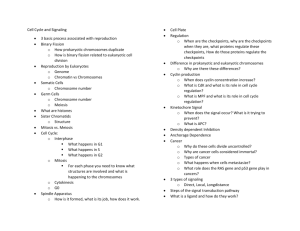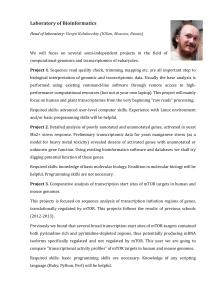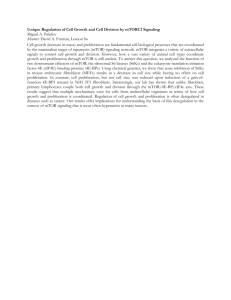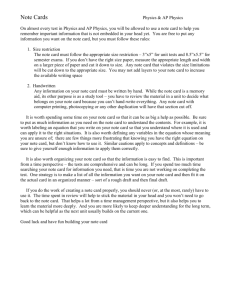DF-Bio714-2-14
advertisement
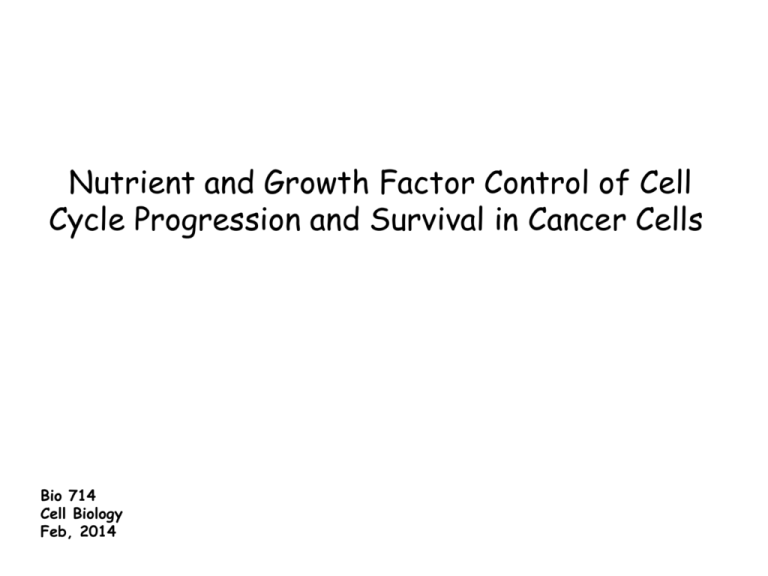
Nutrient and Growth Factor Control of Cell Cycle Progression and Survival in Cancer Cells Bio 714 Cell Biology Feb, 2014 Hurdles in Progression to Cancer I Constitutive Growth Factor Signaling avoid quiescence - cell cycle exit into G0 II Suppression of “Gatekeeper Functions” to get past cell cycle checkpoints III Suppression of Apoptosis avoid default cell death programs IV Acquire Immortality - telomerase expression overcome cell senescence - cancer stem cells? V Stimulate Angiogenesis provide nutrition VI Acquire the ability to migrate and invade gain access to circulation (metastasis) VII Breakdown Caretaker Function genomic instability needed for many mutations Cell Cycle Control and Cancer I Constitutive Growth Factor Signaling avoid quiescence - cell cycle exit into G0 II Suppression of “Gatekeeper Functions” to get past cell cycle checkpoints III Suppression of Apoptosis avoid default cell death programs IV Acquire Immortality - telomerase expression overcome cell senescence - cancer stem cells? V Stimulate Angiogenesis provide nutrition VI Acquire the ability to migrate and invade gain access to circulation (metastasis) VII Breakdown Caretaker Function genomic instability needed for many mutations Regulation of Cell Cycle Progression G0 (Quiescence) Growth Factor Signals Restriction Point G1-pm G1-ps Cell Growth Checkpoint (mTOR) Tyrosine kinases Ras/Raf/MEK/MAPK S Gatekeepers G2 Myc SV40 Early Region (Suppression of p53, Rb and PP2A) M Cooperating Oncogenes and Survival Signals in Tumorigenesis •Weinberg and colleagues demonstrated that signaling oncogenes (Ras) cooperate with gatekeeper override oncogenes (Myc) to transform primary rodent cells - and with SV40 early region genes to transform human cells •Activated Ras by itself - induces apoptosis •Thus, Myc suppresses the apoptosis induced by activated Ras •Signals that lead to elevated Myc provide a “Survival Signal” Foster DA, Yellen P, Xu L, Saqcena M. Genes & Cancer (2011) Conventional View of Cell Cycle Points: The Restriction Point, originally characterized by Arthur Pardee, is a point in G1 where cells no longer require growth factors and commit to completing the cell cycle In the absence of growth factors, cells exit the cell cycle into quiescence or G0 Zetterberg and colleagues have mapped the Restriction Point to a site ~ 3.5 hr after mitosis - where cyclin D is elevated Figure 8.8 The Biology of Cancer (© Garland Science 2007) From: Weinberg, The Biology of Cancer, 2007 Leland Hartwell described a site in the Yeast cell cycle called START that is late in G1 where cells evaluate whether there is sufficient nutrition to complete cell division In some texts, the Restricition Point is referred to as the mammalian equivalent of START - and located near the site where cyclin E is activated Rapamycin treatment results in the activation of TGF- signaling and arrest at the cyclin E site - that can be clearly distinguished both temporally and genetically from the growth factor-dependent Restriction Point Protozoans & Metazoans are… different! Vander Heiden MG, Cantley LC, Thompson CB. Science (2009) Restriction Point (R) G0 G0 G1 R S - GF Restriction Point: Point in G1 after which cells no longer need GF permissive signals to divide. Cell Cycle: START vs. R Yeast Mammalian Restriction Point Cooper GM. The Cell: A Molecular Approach (2000) Pyronnet S, Sonenberg N Curr. Opin. Genetics Dev. (2001) Mammalian Restriction Point is Analogous to START in Yeast • Lodish H, et al. Molecular Cell Biology (2008) What is a Restriction Point ? 3.5 hr + GF M - GF G1 G0 S R Based on Zetterberg and Larsson, PNAS (1985) Competence Factor (PDGF) Progression Factor (IGF1) Based on Pledger and Stiles, PNAS (1979) Where is the Restriction Point ? Dowdy SF, Curr. Opin. Gen Dev (2002) Weinberg RA, Biology of Cancer (2006) Boonstra J, Adv Enzyme Regul (2007) Zetterberg A, Exp Cell Res (2005) Lodish H, Molecular Cell Biology (2008) http://medicinembbs.blogspot.com/ 2011_10_01_archive.html … and where is the Nutrient Sensing ? Genetic requirements for the transformation of human cells (I) (Hahn et al., Nature 400:464, 1999; MCB 22;2111, 2002) Genetic effect Molecular Target Cell cycle target Ras Growth factor signals Restriction point SV40 Large T p53 Rb G1/S checkpoint All G1 checkpoints SV40 small t PP2A Cell Growth checkpoint (?) Genetic requirements for the transformation of human cells (II) (Boehm et al., MCB 25:6464, 2005) Genetic effect Molecular Target Cell cycle target Ras Growth factor signals Restriction point p53 KO Rb KO p53 Rb G1/S checkpoint All G1 checkpoints Myc PTEN KO Gene expression mTORC1 Cell Growth checkpoint (?) Cell Growth checkpoint (?) Foster DA, Yellen P, Xu L, Saqcena M. Genes & Cancer (2011) GF / nutrient deprivation mediate cell cycle arrest Immortalized primary cell line (BJ hTERT) GF / nutrient deprivation mediate cell cycle arrest Sequential Blocking Experiments: 1st Block 2nd Block = No thymidine incorporation + 3H-Thymidine 1st Block = Thymidine incorporation 2nd Block + 3H-Thymidine R & Nutrient Sensing Checkpoints are distinguishable First Block: -EAA 3H-TdR Inc. (%Ctrl) First Block: -GF First Block: -Q First Block: +Rapa. Second Block Conditions A temporal relationship can be established whereby the GFdependent R is upstream from sites that are sensitive to EAA, Q, and mTOR suppression Temporal Mapping of Checkpoints from G0 Indicates that the mTOR control point is at least two hr downstream from the amino acid checkpoints – likely very close to the G1/S boundry GF / Amino acid deprivation and mTOR inhibition impact differentially on PI3K/mTOR signaling GF / AA deprivation and mTOR inhibition: Cell cycle regulators Summary Data support a model where there is GF-dependent R where multi-cellular organisms determine whether it is appropriate for a cell to divide During G1-ps, cells that have been given the green light to divide, determine whether they have the means/raw materials to double the mass of a cell, Replicate its genome, and divide into two daughter cells The late G1 “Metabolic Checkpoints” in late G1 collectively represent a “Cell Growth” checkpoint that responds to nutrients that is evolutionarily equivalent to START in the yeast cell cycle – or mSTART TOR/mTOR is likely the ultimate arbiter for determining nutrient sufficiency Metabolic Checkpoints are Dysregulated in Cancer Cells MCF 7 MDA MB 231 % Cells -GF -EAA -Q +Rapa. Ctrl -GF -EAA -Q +Rapa. Ctrl -GF -EAA -Q +Rapa. # Cells Ctrl Panc-1 C % Cells B % Cells A Ctrl -GF -EAA MCF 7 -Q +Rapa. Ctrl -GF -EAA -Q MDA MB 231 +Rapa. Ctrl -GF -EAA Panc-1 -Q +Rapa. Metabolic Dereguation in Cancer: The Warburg Effect Preferential utilization of glucose through aerobic glycolysis by cancer cells leading to lactate production, independent of the oxygen availability. Only 2 ATPs are formed from glucose to lactate as opposed to 36 ATPs realized by engaging TCA cycle and oxidative phosphorylation. http://cronachedal900.blogspot.com/2012/12/ottowarburg-cura-cancro.html Glutamine supports anaplerosis Glucose ~90% Pyruvate Lipid Synthesis NAD Lactate NADPH Glutamate Glutamine Based on: DeBerardinis RJ, et al. PNAS (2011) Glutamine is “conditionally essential” Gao P, et al. Nature (2009) Glutamine in cell culture • Cancer cell propagation in mouse ascites. • In 1950s, Harry Eagle* formulated a media which can support cell culture in vitro (DMEM). • Key ingredient: Glutamine! • “Added glutamine since serum had lots of glutaminase in it…” –Jim Darnell, Jr. • Started adding excess glutamine (over 10-fold greater than any other amino acids), so that it is not a “growth-limiting” component of the medium. *Eagle, H. Nutrition needs of mammalian cells in tissue culture. Science (1955) Genetic mutations determine differential glutamine sensitivity displayed by cancer cells A B Mutant K-Ras WT K-Ras Glutamine deprivation causes loss of cell proliferation Dual inhibition of K-Ras/MAPK and PI3K/mTOR pathway restores glutamine-mediated G1 cell cycle arrest % Non-viable cells Glutamine deprivation creates synthetic lethality for cytotoxic drugs – Capecitabine and Paclitaxel Cape. Pacli. C+P Ctrl Cape. Pacli. C+P Ctrl Cape. Pacli. C+P Ctrl Cape. Pacli. C+P % Non-viable cells Ctrl AOA and EGCG inhibit glutamine utilization Aminotransferase inhibitor Amino-oxyacetate (AOA) α-KG + Asp GOT Glutamate dehydrogenase inhibitor Epigallocatechin gallate (EGCG) Glu + Glu Gln % Cells GDH Blocking glutamine utilization creates synthetic lethality to cell cycle phase-specific cytotoxic drugs in K-Ras mutant cancer cells AOA Conclusions • Amino acids and mTOR mediate distinct late-G1 metabolic checkpoints. • Cancer cells with K-Ras mutation override the amino acid-mediated G1 cell cycle checkpoints and these cells arrest in S and G2/M. • Thus, the aberrant response to amino acid deprivation could prove to be an Achilles’ heel in K-Ras mutant cancer cells – by sensitizing cancer cells to agents that kill cells in S-phase. • Ras is mutated in ~30% of all cancers, occurs in over 90% of pancreatic cancers , which has 5-year survival rate of less than 5%. However, it is considered “therapeutically undruggable” owing in part to its extremely high affinity with GTP (in the picomolar range). Complementing oncogenic alterations dysregulate Restriction Point and Cell Growth checkpoints Restriction Point Cell Growth Checkpoint mTOR Signals Growth Factor Signals Ras Insulin/IGF1 PI3K PIP3 PIP2 PTEN mTORC2 PDK1 Raf Akt Ser473 T308 TSC1/2 Mek Amino acids Rheb PLD1 MAPK FKBP38 mTORC1 S6K TGF- Myc Cyclin D Cyclin E AMP LKB1 AMPK Energy status Conclusions The GF-dependent R can be distinguished from late G1 metabolic checkpoints and mTOR The G1 metabolic checkpoints – like R – are dysregulated in human cancer cells Cooperating genetic alterations in cancer cells disable both R and the late metabolic checkpoints that collectively may represent a “Cell Growth” checkpoint with mTOR as the final arbitor Surprisingly, mTOR, which is widely known to be regulated by amino acids, blocked cell cycle progression well downstream of the amino acid sites It is hypothesized that other nutrient inputs – such as glucose and phosphatidic acid (lipids) may be required for complete activation of mTOR and progression into S-phase Growth Factor Signals Cell Growth Checkpoint (START) Restriction Point G1-pm G1-ps Nutritional Sufficiency Amino acids Fatty acids Energy ATP RalA O2 Vps34 Cell Size Nutritional Sufficiency S Cyclin D-CDK4/6 Cyclin E-CDK2 G0 Cyclin A-CDK2 Rheb PLD mTOR TGF- Commitment Cell Growth
